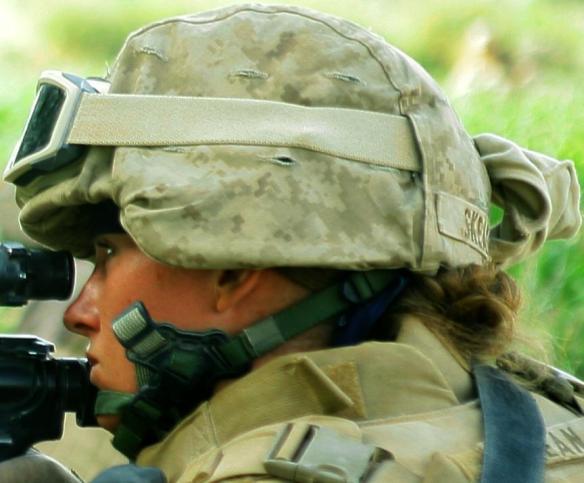
U.S. Marine Corps sergeant Angailque Skean provides security during a cordoned search in Helmand Province, Afghanistan, July 28, 2009. Skean was a member of one of the highly effective Female Engagement Teams working to reduce Taliban influence among the Afghan population.
Women’s participation in military operations greatly expanded in scope and experience during Operations Enduring Freedom (the coalition effort in Afghanistan) and Iraqi Freedom (the Iraq War). More women deployed, performed a greater variety of occupational specialties, and were dispersed more widely across active theaters of operations than ever before in U. S. military history. According to figures produced by the Defense Manpower Data System, as of September 2006, 112,832 women had deployed to these two operations, representing 11.1 percent of the active duty personnel. This figure is nearly double the just more than 6 percent female personnel who deployed to the Persian Gulf region earlier in Operation desert storm (1991).
The U. S. Air Force deployed the largest number of women, roughly 15.8 percent, trailed closely by the U. S. Army and the U. S. Navy at 11 percent and 11.1 percent, respectively. The U. S. Marine Corps reported just 3.4 percent. Although the prohibition of women in direct ground combat remains in effect, many women found themselves under fire while in transportation convoys, returning fire in defensive combat roles and performing the majority of all available military duties. Military necessity dispersed women to geographically diverse positions throughout the theater of operations.
While American women have always participated in military operations, few routinely deployed to active theaters of combat. This limitation reflected not only societal norms and expectations but also legislative and policy restrictions. In 1993 U. S. secretary of defense Les Aspin, following legislative action by the U. S. Congress, removed policy restrictions that barred women from training for combat aviation missions. Female aviators flew combat missions in 1998 for the first time over the no-fly zone in Iraq. Moreover, by 1994 the Department of Defense had abolished the risk rule, which prohibited women from serving in ground combat support groups. This action opened the bulk of all military occupational specialties to female personnel. More recently, policy makers reviewed the prohibition of women in units engaged in direct ground combat missions in response to the increased strain on forces brought about by the extended deployment in Iraq and Afghanistan.
Currently women routinely participate in a wide variety of missions, and there are no prohibitions on temporary excursions into active areas of combat. Indeed, women are essential to maintaining the volunteer military, and the armed forces continue to regard females as an important target audience for recruiting efforts.
Although it is too early to identify the effect that this level of participation will exert on American women, gender relations, societal norms, and the military, there are some indicators of the direction that legacy may take. Increased claims of sexual harassment and incidents of sexual assault suggest that the services and the country they serve have not yet resolved the intricacies involved in integrating and deploying a two-gender operational military force. Some psychology professionals claim that women may be more susceptible to stress-induced conditions such as post-traumatic stress disorder and that they may require longer and more intensive treatment to fully recover, possibly placing women at a disadvantage in certain positions.
The increased number of deployed women with children calls into question the advisability of an expanded role for mothers, especially single mothers, in extended military deployments. Although military personnel who are parents designate alternative caregivers should their unit be deployed, policy makers and society may consider the individual effect on the well-being of children, given these long parental separations and the daily stress inherent with the realization for a child that her or his mother may be in harm’s way. Other military analysts wonder if the American public is willing to accept larger numbers of female casualties or women as prisoners of war. Relatively small numbers of each thus far have not brought Americans face to face with these possibilities.
Finally, many observers question whether or not the ground combat exclusion is a valid concept in the era of modern warfare in which battles occur in virtually 360 degrees, the front lines are nonexistent, and the enemy neglects to respect civilian noncombatant status, let alone gender, as a relative factor in pursuing hostilities. These and other issues will be the legacy of women’s increasing participation in U. S. military operations. The experiences of female soldiers, sailors, air personnel, and marines, along with those of their male counterparts during Operations Enduring Freedom and Iraqi Freedom, will undoubtedly guide policy makers and military leaders as they strive to provide effective forces, equal opportunities, and comparable responsibilities for all U. S. military personnel.